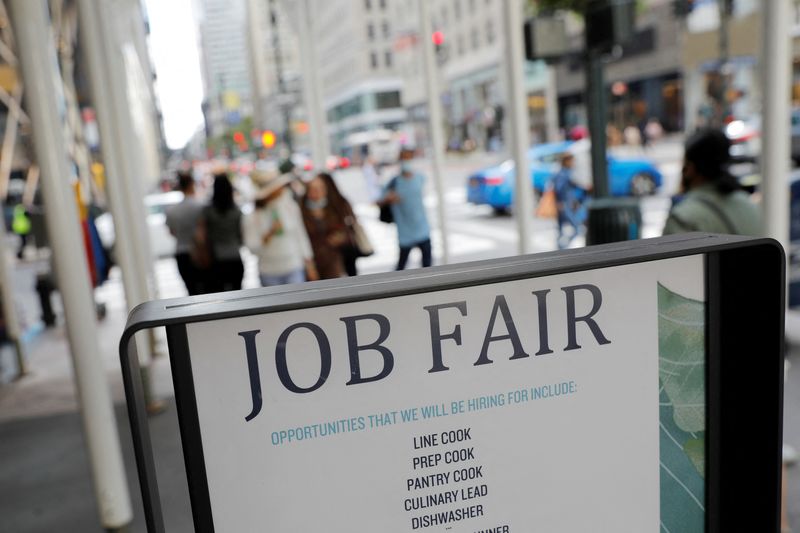By Lucia Mutikani
WASHINGTON (Reuters) - The number of Americans filing new claims for unemployment benefits jumped to a three-month high last week, likely as a winter wave of COVID-19 infections disrupted business activity, which could constrain job growth this month.
The third straight weekly increase in jobless claims reported by the Labor Department on Thursday was also influenced by unfavorable seasonal factors after the holidays. Coronavirus cases, driven by the Omicron variant, are subsiding and the seasonal factors, the model used by the government to iron out seasonal fluctuations from data, are seen normalizing soon, suggesting the recent surge in claims is a blip.
"The Omicron variant of COVID-19 is hurting the U.S. labor market, but the good news is that this will be temporary," said Ryan Sweet, a senior economist at Moody's (NYSE:MCO) Analytics in West Chester, Pennsylvania.
Initial claims for state unemployment benefits surged 55,000 to a seasonally adjusted 286,000 for the week ended Jan. 15, the highest level since mid-October. The increase was the largest since last July. Economists polled by Reuters had forecast 220,000 applications for the latest week.
Unadjusted claims fell 83,418 to 337,417 last week. The decline was, however, less than the 138,773 decrease that had been anticipated by the seasonal factors.
Claims rose 6,075 in California. But they plunged 14,011 in New York. There were also big drops in Missouri and Texas.
The United States is reporting an average of 752,698 new coronavirus infections a day, according to a Reuters analysis of official data.
Latest data from the Census Bureau's Household Pulse Survey showed more than 8 million people reported not being at work because of coronavirus-related reasons between Dec. 29 and Jan. 10. That was up from the 3 million from Dec. 1 to Dec. 13.
With signs that the Omicron wave has crested in some regions, including hard-hit New York, the setback to the labor market is unlikely to stop the Federal Reserve from raising interest rates in March to tackle high inflation.
Claims have plunged from a record high of 6.149 million in early April 2020. Employers are desperate for workers, with 10.6 million job openings at the end of November. The unemployment rate is at a 22-month low of 3.9%, a sign the labor market is at or close to maximum employment.
"The underlying strength in the labor market suggests this is a temporary blip due to Omicron," said John Lynch, chief investment officer at Comerica (NYSE:CMA) Wealth Management in Charlotte, North Carolina. "We look for job growth to continue to firm as global cyclical recovery persists."
Stocks on Wall Street were trading higher. The dollar was steady against a basket of currencies. U.S. Treasury prices rose.
BAD OMEN?
But some economists worried that the jump in claims, which followed a plunge in retail sales in December as well as manufacturing production, could be signaling a faster slowdown in economic activity than currently anticipated.
"The higher layoffs are a cautionary tale for the economy where despite inflation pressures, the Fed will have to proceed with their interest rate hikes at a measured pace," said Christopher Rupkey, chief economist at FWDBONDS in New York. "The economy may be slowing down more than previously believed."
There are, however, indications that manufacturing is picking up, though shortages and higher prices remain a headache.
The Philadelphia Fed said on Thursday its business activity index rose to a reading of 23.2 in January from 15.4 in December. Any reading above zero indicates expansion in the region's manufacturing sector, which covers eastern Pennsylvania, southern New Jersey and Delaware.
News on the housing market was discouraging. A report from the National Association of Realtors showed existing home sales dropped 4.6% to a seasonally adjusted annual rate of 6.18 million units in December as higher prices amid record low inventory continued to shut out some first-time buyers.
Economists expect demand for housing to remain strong even as mortgage rates increase.
"Unless job and income growth slow sharply, owner-occupied housing demand is likely to remain solid, keeping upward pressure on house prices," said David Berson, chief economist at Nationwide in Columbus, Ohio.
Worker shortages are boosting wages and households are sitting on a pile of savings accumulated during the pandemic.
The claims data covered the period during which the government surveyed businesses for the nonfarm payrolls component of January's employment report.
Claims are significantly higher than their level in mid-December, suggesting moderate job growth this month.
The economy added 199,000 jobs in December, the fewest in a year. The workforce is about 2.2 million people smaller than before the pandemic.
The recent softening in the labor market trend was also highlighted by the claims report, which showed the number of people receiving benefits after an initial week of aid increased 84,000 to 1.635 million in the week ended Jan. 8.

Still, these so-called continuing claims stayed below 2 million for the eighth straight week.
"The pandemic continues to displace workers from the labor force," said Van Hesser, chief strategist at Kroll Bond Rating Agency in new York. "We need the labor force to grow to sustain healthy economic growth."